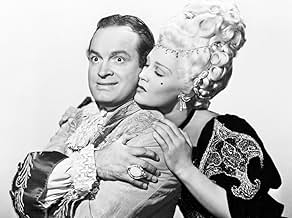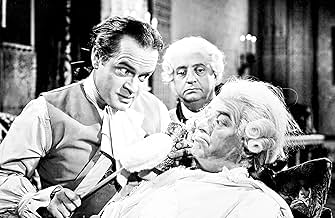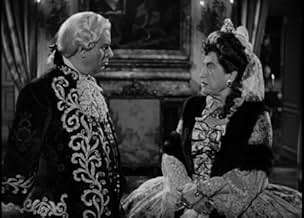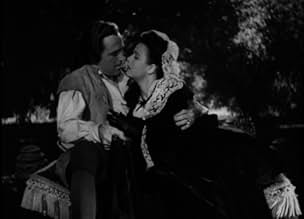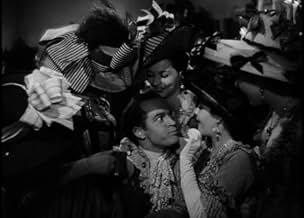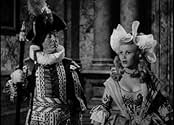A bumbling barber in the court of King Louis XV becomes engaged in political intrigue when he masquerades as a dashing nobleman engaged to the princess of Spain.A bumbling barber in the court of King Louis XV becomes engaged in political intrigue when he masquerades as a dashing nobleman engaged to the princess of Spain.A bumbling barber in the court of King Louis XV becomes engaged in political intrigue when he masquerades as a dashing nobleman engaged to the princess of Spain.
- Awards
- 1 win total
- Swordsman
- (uncredited)
- Women Who Gets Dress Ripped Off
- (uncredited)
- Court Jester
- (uncredited)
- Wife
- (uncredited)
Featured reviews
He actually does some quite decent acting in this one. The character of the barber Beaucaire is more romantic and less cynical than the comedian Hope.
Hope has surrounded himself with some of the most talented people in Hollywood. Cinematographer Lionel Lindon was nominated three times for an Oscar and won once with "Around the World in 80 Days." Film Editor Arthur P. Schmidt was nominated twice (for "Sayonara" and "Sunset Blvd.") Composer Robert Dolan was nominated 8 times between 1942 and 1947. Sadly, he never won. He should have been nominated for this movie, but he was already nominated for "Blue Skys" in 1946. Art Director, Hans Dreier, was nominated 20 times and won 4 Oscars. He should have been nominated for this movie, but he already had two other nominations in 1946. Set Decorator, Sam Comer was nominated 22 times and also won 4 Oscars. Male Costume Designer Giles Steele got 4 nominations and won twice. Mary Kay Dobson. who did the exquisite gowns in this film, was never nominated, but she should have won an Oscar for the fantastic four foot wide hooped skirts the women wear.
Hope was never nominated for an Oscar, but this is the one movie where I think his performance merited consideration.
Joan Caulfield, in only her second film, is dazzling. As Mimi, Beaucaire's love interest, she is hilarious and has excellent chemistry with Hope. The same year, she played the love interest of both Fred Astaire and Bing Crosby in "Blue Skys". Everybody else in the cast is just delightful.
The funniest scene is when Beaucaire meets the King of Spain. Beaucaire is pretending to be an aristocrat. He is told to act "distainful" When they meet, Beaucaire and the King just glare at each other through lorngettes (opera glasses).
Second funniest is when Beaucaire gets exposed as a barber and slapped. The king tells him to slap the fellow back. "Everybody is entitled to his opinion," answers Hope meekly, "Why if I had a sword..." A lackey offers his sword to Hope, who quickly pushes him away, saying, "Mind your own business." If you're in the mood for a wonderful and sweet old romantic comedy, put across by some of the most talented people in the golden age of Hollywood, don't miss it.
The film finds Bob playing a barber in the latter portion of Louis XV's reign (about 1770 more or less). Naturally Bob is a bit of a screw up and gets in trouble. But, there is a way out--he has to agree to pose as the Duke--a man who is to marry the Spanish princess and solidify an alliance between the countries. But, no one realizes that a crazy Spanish general (Joseph Schildkraut) has plans to kill the Duke, as he WANTS the countries at war with each other! So, it's up to the cowardly Hope to try to save his butt and, hopefully, find love. As for the Duke (Patric Knowles), he's fallen in love with a woman and doesn't really want to marry a princess he's never met. Can it all work out in the end and everyone live happily ever after?
The movie is relatively low on laughs--particularly the climactic sword-fighting scene (it's rather lame). But, Hope is an agreeable personality in the film and that makes up for the problems...which would include the3 fact that NONE of the French or Spanish people looked or talked like they came from these countries. Heck, Schildkraut was Austrian and sounded NOTHING like a Spaniard! And Hope seemed about as French as Nelson Mandella! Still, a nice and agreeable little film.
By the way, the original "Monsieur Beaucaire" was a silent film starring Rudolph Valentino and was not a comedy. Also, although this is only of interest to history teachers, the film talked about the guillotine several times, though it was not used for the first time until about 1791--during the French Revolution.
Hope is Beaucaire, a court barber in costume-era France. He gets mixed up in court politics and intrigue; poses as the Duc le Chandre, renowned lover and duelist; and chases after his girlfriend Mimi—who may or may not reciprocate his romantic feelings but certainly has adventures of her own.
The entire cast is lively and beautiful in this very funny picture. Joan Caulfield as Mimi is bright, charming and silly; Marjorie Reynolds as a Spanish princess is lovely. Patric Knowles is dashing enough as the notorious duke—he is the perfect choice (King Louis thinks) to be shipped off to marry said Spanish princess, not only for political reasons but because all the "young bloods" in Paris will be happy to be rid of him. Cecil Kellaway is the harried count whose difficult duty it is to transport the reluctant duke to the arranged wedding site.
Reginald Owen is hilariously un-regal as King Louis, and owns every scene he is in. Other highlights include a goofy palace swordfight between Hope and villain Joseph Schildkraut that involves a harp, a bass fiddle, and a harpsichord.
Funny and fast-paced .A couple of decent songs and the usual assortment of Hope one-liners add up to a very enjoyable picture.
Everyone does a great job of it, including Hillary Brooke as Madame Pompadour, Constance Collier as the Queen of France and Cecil Kellaway as Count D'Armand.
Watch and have fun!
Did you know
- TriviaOne of over 700 Paramount Productions, filmed between 1929 and 1949, which were sold to MCA/Universal in 1958 for television distribution, and have been owned and controlled by Universal ever since. Its initial television broadcast took place in Seattle Saturday 29 November 1958 on KIRO (Channel 7); it first aired in Boston Wednesday 4 February 1959 on WBZ (Channel 4) and in Minneapolis Sunday 8 February 1959 on WTCN (Channel 11), and as it slowly spread across the USA, it was not long before it became a popular local favorite. In Milwaukee it first aired Sunday 12 April 1959 on WITI (Channel 6), in Denver 18 May 1959 on KBTV (Channel 9), in St. Louis 23 May 1959 on KMOX (Channel 4), in Chicago 10 October 1959 on WBBM (Channel 2), in Phoenix 28 November on KVAR (Channel 12), in Philadelphia 5 December 1959 on WCAU (Channel 10), in San Francisco 27 December 1959 on KPIX (Channel 5), in Pittsburgh 14 January 1960 on KDKA (Channel 2), in Des Moines 27 January 1960 on WHO (Channel 13), in Wichita 29 January 1960 on KTVH (Channel 12), and in Toledo 15 February 1960 on WTOL (Channel 11). It was released on DVD 8 October 2002 in tandem with A vos ordres ma générale (1947) as part of Universal's Bob Hope: The Tribute Collection, and again as a single 30 October 2015 as part of the Universal Vault Series.
- GoofsReferences are made to the guillotine as a means of execution. The guillotine was not invented until the reign of King Louis XVI.
- Quotes
Mimi: Oh, you're so right. One look is enough.
Monsieur Beaucaire: That regal forehead runs in the family.
Mimi: The Hapsburg chin!
Monsieur Beaucaire: Got that from my mother.
Mimi: The Bourbon nose!
Monsieur Beaucaire: Got that from my father, drank like a fish!
Mimi: Those dark, flashing eyes - that soft lustrous hair!
Monsieur Beaucaire: You should see it after a rinse!
- ConnectionsFeatured in Bob Hope at 100 (2003)
- How long is Monsieur Beaucaire?Powered by Alexa
Details
- Runtime
- 1h 33m(93 min)
- Color
- Aspect ratio
- 1.37 : 1



